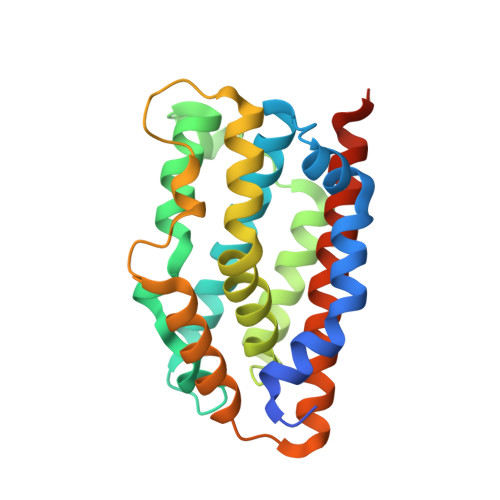Crystal structures of the ferric, ferrous, and ferrous-NO forms of the Asp140Ala mutant of human heme oxygenase-1: catalytic implications
Lad, L., Wang, J., Li, H., Friedman, J., Bhaskar, B., Ortiz de Montellano, P.R., Poulos, T.L.(2003) J Mol Biol 330: 527-538
- PubMed: 12842469
- DOI: https://doi.org/10.1016/s0022-2836(03)00578-3
- Primary Citation of Related Structures:
1OYK, 1OYL, 1OZE, 1OZL, 1OZR, 1OZW - PubMed Abstract:
Site-directed mutagenesis studies have shown that Asp140 in both human and rat heme oxygenase-1 is critical for enzyme activity. Here, we report the D140A mutant crystal structure in the Fe(III) and Fe(II) redox states as well as the Fe(II)-NO complex as a model for the Fe(II)-oxy complex. These structures are compared to the corresponding wild-type structures. The mutant and wild-type structures are very similar, except for the distal heme pocket solvent structure. In the Fe(III) D140A mutant one water molecule takes the place of the missing Asp140 carboxylate side-chain and a second water molecule, novel to the mutant, binds in the distal pocket. Upon reduction to the Fe(II) state, the distal helix running along one face of the heme moves closer to the heme in both the wild-type and mutant structures thus tightening the active site. NO binds to both the wild-type and mutant in a bent conformation that orients the NO O atom toward the alpha-meso heme carbon atom. A network of water molecules provides a H-bonded network to the NO ligand, suggesting a possible proton shuttle pathway required to activate dioxygen for catalysis. In the wild-type structure, Asp140 exhibits two conformations, suggesting a dynamic role for Asp140 in shuttling protons from bulk solvent via the water network to the iron-linked oxy complex. On the basis of these structures, we consider why the D140A mutant is inactive as a heme oxygenase but active as a peroxidase.
Organizational Affiliation:
Department of Molecular Biology and Biochemistry, University of California at Irvine, Irvine, CA 92697-3900, USA.















